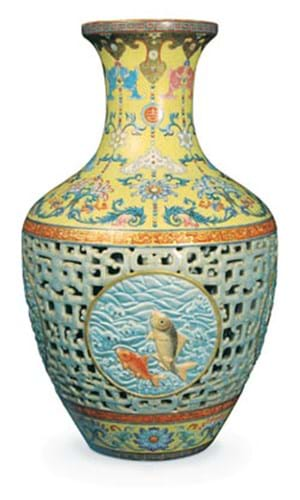
The price (£51.6m including buyer's premium) puts it in the top ten works of art ever sold at auction, an exclusive list that up to now has only been occupied by paintings and sculpture sold by either Sotheby's or Christie's.
Despite its modest recent history, the 16in (41cm)yang cai reticulated double-walled vase with famille rose decoration would have been a commission for one of the palaces of the Qianlong Emperor (1736-1795), probably the Summer Palace or the Forbidden City.
According to the world's leading dealers and collectors, it is the best object of its type to be seen on the market in decades, but it also chimes perfectly with current Chinese taste that values pieces from this period above all others.
Peter Bainbridge, the auctioneer, who runs a typical local auction room, is likely to have become a multi-millionaire himself as a result of the sale. His buyer's premium for this sale was 20 per cent, or £8.6m, while he could have charged the vendors anything up to 17.5 per cent, or just over £7.5m, to sell it.
Opening at £500,000 (the estimate prior to sale was £800,000-1.2m), the bidding on the evening of November 11 took 18 minutes, with the hammer falling at around 6.30pm to gasps and applause from a room packed with the world's leading dealers and collectors and their representatives.
In the week running up to the sale, members of the trade considered anything between £18m and £30m might be possible, but even in the context of a rapidly rising market, many thought the higher figure was fanciful. The consensus after the sale was that it would not have made a penny more if sold in Hong Kong or Mayfair.
Seasoned dealers and collectors in town for Asian Art in London had patiently queued along Dover Street on November 8 when Peter Bainbridge brought the vase to the capital to be viewed.
Those who missed that chance were able to inspect it up to the moment of sale in the incongruous surroundings of Bainbridges' cluttered storeroom, where it sat on a metal table next to the kitchen. Despite its former tenure on top of a wardrobe, it was in near perfect condition.
In scenes that were unprecedented outside the world's leading auction rooms, eight or ten serious buyers were bidding into the millions, either in person or on the phone. The successful buyer, a leading mainland Chinese collector, was represented in the room by his agent. Speaking to ATG immediately after the purchase, a Chinese translator commented: "This is a very, very important, rare and splendid item. We have never seen such a beautiful thing outside China and it is good that a Chinese buyer has bought it."
His client had only heard about the vase two days before the sale.
The price establishes a swathe of new auction landmarks. The previous world record for Chinese porcelain (an accolade once reserved for much earlier pieces of blue and white coveted for centuries by Western collectors) was set at Sotheby's Hong Kong only weeks ago when a double gourd yellow ground vase, again made for the Qianlong Emperor, sold to the Chinese business magnate and collector Alice Cheng for HK$225m (£18.2m).
The Ruislip vase also surpasses the previous record for any Chinese work of art, the RMB390m (£37m) for an 11th century calligraphic scroll by Huang Tingjian sold at Beijing Poly this June.
Only paintings or sculpture by a handful of major Western artists have sold for more at auction: at £43m the vase slots into eleventh place on the all-time list, just behind Rubens' Massacre of the Innocents sold for £45m at Sotheby's in 2002. Indeed, only three works of art have ever sold for more in the UK.
After news of the sale spread, a crew from Sky News arrived late at night to report an unprecedented auction event with the perfect back story. For filming the auctioneer removed the £51.6m masterpiece from its protective carrying case - a Waitrose cardboard box.
Links:
More on the Qianlong porcelain masterpiece




